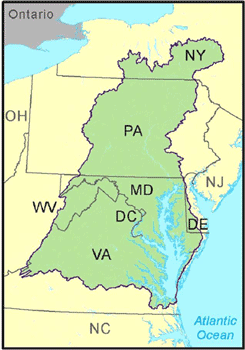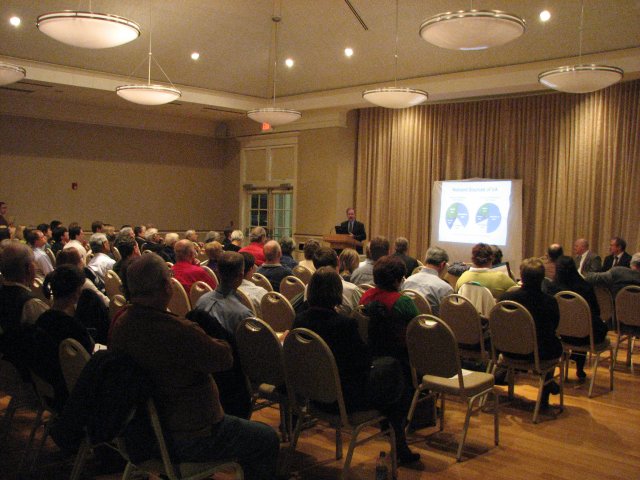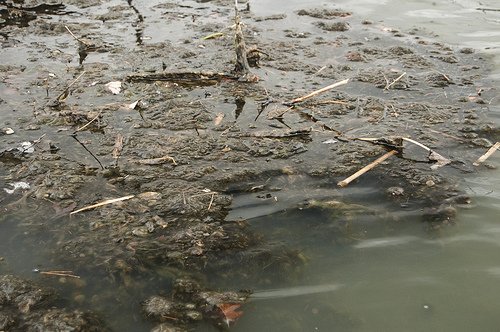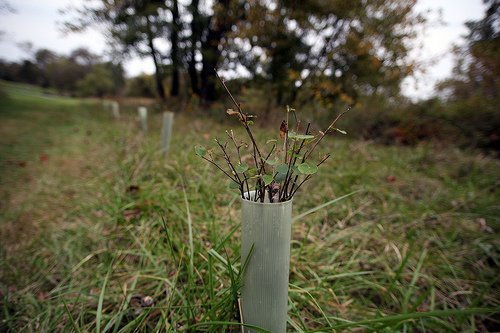Chesapeake Bay TMDL Fact Sheet

Driving Actions to Clean Local Waters and the Chesapeake Bay
On December 29, 2010, the U.S. Environmental Protection Agency (EPA) established the Chesapeake Bay Total Maximum Daily Load (TMDL), a historic and comprehensive “pollution diet.” The TMDL is the largest ever developed by EPA, encompassing a 64,000-square-mile watershed.
Why a TMDL?
The Chesapeake Bay and its tributaries contain excess nutrients and sediment from various sources such as agricultural operations, urban and suburban stormwater, wastewater, and airborne contaminants. The excess nutrients and sediment lead to murky water and algae blooms, which block sunlight from reaching and sustaining underwater Bay grasses, and create low levels of dissolved oxygen, which is critical for aquatic life such as fish, crabs, and oysters.
Despite extensive restoration efforts during the prior 25 years, the Bay was still impaired, so the Bay jurisdictions (Delaware, Maryland, New York, Pennsylvania, Virginia, West Virginia, and the District of Columbia) asked EPA to develop the TMDL. The TMDL also fulfilled consent decree commitments in Virginia and the District of Columbia from the late 1990s and was a keystone commitment of a federal strategy to meet President Barack Obama’s Executive Order 13508 to restore and protect the Bay.
A TMDL is a planning tool that provides the calculation of the maximum amount of a particular pollutant that a body of water can receive and still meet applicable water quality standards. Water quality standards include a designated use (the desired condition of a water) and parameter-specific water quality criteria to protect that use. When the TMDL was established, monitoring data continued to show that the Bay had poor water quality, degraded habitats, and low populations of many species of fish and shellfish.
The Bigger Picture
The TMDL is only one step in the larger planning and Bay restoration process. The Bay jurisdictions have entered into Bay Agreements since 1983, articulating their commitments to restore the Bay – not just water quality, but also sustainable fisheries, vital habitats, stewardship, climate resiliency and more. The most recent Chesapeake Bay Watershed Agreement was signed in 2014.
In 2007, the Chesapeake Bay Program (CBP) partnership agreed to the overall goal of having practices in place to restore the Bay by 2025. The CBP partnership also agreed to an Accountability Framework to help meet the 2025 goal. The Accountability Framework includes four elements: Watershed Implementation Plans (WIPs) developed by the Bay jurisdictions, two-year milestones to break those WIPs into two-year segments, EPA’s tracking and accounting of progress, and EPA’s commitment to take federal actions, as needed, to ensure progress is made.
The final TMDL itself was shaped by an extensive two-year public involvement effort and, in large part, by the Bay jurisdictions’ final Phase I WIPs. The Phase I WIPs – the first of three phases of WIPs – were developed by the jurisdictions and detailed how and when the jurisdictions would meet their major river basin targets. In the most recent 2014 Chesapeake Bay Watershed Agreement, the Bay jurisdictions reaffirmed their commitment to implementing the TMDL as part of the overall multi-jurisdictional plan to restore water quality in the Bay.
What does the TMDL do?
The TMDL identified the overall loading capacity of nitrogen, phosphorus, and sediment that can be present in the Bay to achieve applicable water quality standards – specifically, the TMDL set Bay watershed limits of 185.9 million pounds of nitrogen, 12.5 million pounds of phosphorus, and 6.45 billion pounds of sediment per year. This equates to a 25 percent reduction in nitrogen, 24 percent reduction in phosphorus, and 20 percent reduction in sediment from the base year of 2009. The TMDL pollutant limits were further divided by jurisdiction and major river basin based on state-of-the-art modeling tools, extensive monitoring data, peer-reviewed science, and close interaction with the Bay jurisdictions.
The TMDL also included targeted “backstop allocations” and “backstop adjustments” for areas where certain jurisdictions’ final Phase I WIPs did not meet the major river basin targets or EPA’s expectations of reasonable assurance that those targets would be met. Also, the TMDL included EPA’s commitment to reduce air deposition of nitrogen to the tidal waters of the Bay from 17.9 to 15.7 million pounds per year through federal air regulations.
The TMDL is actually a combination of smaller TMDLs for 92 individual Chesapeake Bay tidal segments. It includes pollutant loads that EPA determined were sufficient to meet applicable state water quality standards for dissolved oxygen, water clarity, underwater Bay grasses, and chlorophyll a, an indicator of algae levels.


Addressing the Challenges
The CBP partnership has continued to work to restore the Bay since establishment of the TMDL. Both Phase I and Phase II WIPs described actions and controls the Bay jurisdictions committed to implement by 2017 and 2025 to achieve applicable water quality standards. In 2012, the Bay jurisdictions submitted Phase II WIPs designed to strengthen the initial cleanup strategies and reflect the involvement of local partners. The Phase II WIPs were built upon the knowledge and experience gained from implementation of the initial Phase I WIPs using a process called adaptive management.
The Bay jurisdictions developed Phase III WIPs based on a 2018 midpoint assessment that analyzed the progress made and the lessons learned from implementation of the Phase I and Phase II WIPs. The Phase III WIPs provide the plan for actions the Bay jurisdictions intend to implement between 2018 and 2025 to meet the Bay restoration goals.
The Bay jurisdictions and federal agencies also submit two-year milestones each even numbered year outlining near-term restoration commitments. Two-year milestones provide greater specificity of actions; strategies and load reductions; more rigorous assurances that load reductions will be achieved; and more transparent reporting to the public.
Actions taken by the Bay jurisdictions to implement the TMDL will have significant benefits far beyond the tidal Chesapeake Bay itself. Benefits include helping to clean rivers and other waterways that support local economies, recreational pursuits like fishing and swimming, and public health benefits like protecting drinking water sources and improved local water quality.

Actions under the TMDL will also have significant benefits far beyond the Chesapeake Bay itself. Benefits include helping to clean rivers and other waterways that support local economies and recreational pursuits like fishing and swimming, and serve as drinking water sources.
In 2012, the jurisdictions submitted Phase II Watershed Implementation Plans designed to strengthen the initial cleanup strategies and reflect the involvement of local partners. They also submitted sets of two-year milestones in 2012 and 2014 outlining near-term restoration commitments. Phase III WIPs in 2017 will be designed to provide additional detail of restoration actions beyond 2017 and to ensure that the 2025 goals are met.
To view this fact sheet in PDF format, please click the link below:
